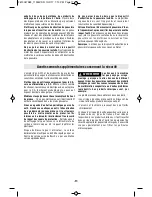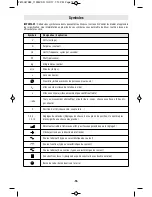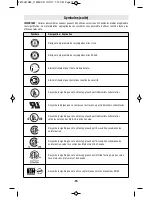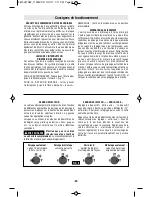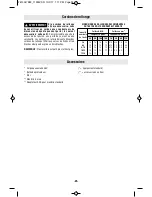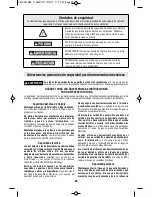
TOOL TIPS
Following a few simple tips will reduce wear on
the tool and the chance of injury to the
operator.
NOTE:
The high efficiency available from the
rotary hammers can only be obtained if sharp
and undamaged accessories are used. The
“cost” to maintain sharp and undamaged
accessories is more than offset by the “time
saved” in operating the tool with sharp
accessories.
All hammers require a short period of time to
warm up. Depending on the room temperature,
this time may vary from approximately 15
seconds (90˚F) to 2 minutes (32˚F).
A new hammer requires a break-in period
before full performance is realized. This period
may require up to 5 hours of operation.
You will extend the life of your bits and do
neater work if you always put the bit in contact
with the workpiece BEFORE pulling the trigger.
During operation, hold the drill firmly and exert
moderate, steady pressure. Too much
pressure at low speed will stall the hammer.
Too little pressure will keep the bit from cutting
and cause excess friction by sliding over the
surface. This can be damaging to the drill and
bit.
Carbide tipped bits:
Used for drilling stone,
concrete, cement, brick, cinder block and other
unusually hard non-metals.
3-JAW CHUCK
(Drill only mode)
The 3-Jaw Chuck with SDS-plus
®
Shank
Adaptor accessory can convert your tool for
use with straight shank bits.
Shanks of all drill bits should be wiped clean
prior to using and immediately after removing.
Recall these instructions for safe
operation:
1. All work must be supported or secured
before drilling and steady, even pressure
applied in line with the drill bit.
2. As the drill bit cuts through the opposite
side, reduce the pressure and continue
running the drill as the bit is withdrawn.
3. Some materials require slow drilling
speeds; whereas, others require higher speed
to produce the best results. Materials such as
glass, porcelain, ceramics, tiles, plastics, etc.,
should be drilled at low speeds with specially
designed drill bits and lubricants.
DRILLING WOOD OR PLASTIC
(Drill only mode)
If backing block is not used, ease up on the
pressure just before the bit breaks through the
wood to avoid splintering. Complete the hole
from the opposite side immediately after the
point breaks through. If bit binds, reverse the
drilling operation to help remove the bit from
the work.
DRILLING METAL
(Drill only mode)
There are two rules for drilling hard materials.
First, the harder the material, the greater the
pres sure you need to apply to the tool.
Second, the harder the material, the slower the
speed. Here are a couple of tips for drilling in
metal. Make a center punch in the material for
easier starting. Lubri cate the tip of the bit
occasionally with cutting oil except when
drilling soft metals such as alu minum, cop per
or cast iron. If the hole to be drilled is fairly
large, drill a smaller hole first, then enlarge to
the required size, it’s often faster in the long
run. Main tain enough pressure to assure that
walkways and working areas with
bystanders. The tool could be bumped or a
bystander could become entangled in the
power supply cord causing the tool to
unexpectedly fall.
To reduce the risk of
injury, Do not use the
hanging hook if it appears damaged or
deformed. This could result in unstable
hanging and the tool unexpectedly falling.
When not in use, always
close hook until it snaps
into the closed position.
-11-
!
WARNING
HAMMERHOOK
™
FIG. 7
To Open
To Close
2610047983_11253VSR 10/2/17 1:10 PM Page 11

















